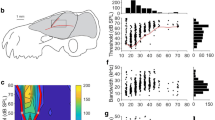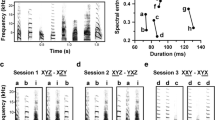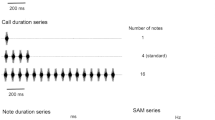Summary
The tonotopic organization of the cochlear nucleus (CN) of the mustache bat, Pteronotus parnellii was studied by injecting horseradish peroxidase (HRP) in physiologically characterized CN-sites known to respond to a certain frequency. The tracer was transported by the branched fibers of the auditory nerve and bands of labeled terminals were found in each of the CN-subdivisions. Low to high frequencies are orderly represented in rostrocaudal direction in the anteroventral CN (AV) and in ventrodorsal direction in the posteroventral (PV) and dorsal CN (DCN). In all 3 subnuclei a vast overpresentation of the frequency band between 54–66 kHz, which includes the dominant second harmonic of the echolocation calls, is superimposed on this basic mammalian pattern of frequency representation. A deviation from the standard mammalian scheme of tonotopic arrangement is found in the cytoarchitecturally distinct ‘marginal cell group’ (MA). This cell group extends in rostrocaudal direction along the medial margin of the AV, and the frequency representation in its most rostral 2 thirds is biased towards the low frequency range of the faint first harmonic of the echolocation call (24–32 kHz). Consequently the low frequencies lie adjacent to the regular slab organization of the range of higher frequencies represented in the AV. The temporal response patterns of MA neurons to tone stimuli are predominantly phasic or onset-types, in contrast to the ‘primary like’ response type which prevails in the AV. The frequency representation and the physiological characteristics of the MA group can be relevant in the context of target range determination by echolocation.
Similar content being viewed by others
Abbreviations
- AV :
-
anteroventral cochlear nucleus
- AV a :
-
anterior part of AV
- AV p :
-
posterior part of AV
- BF :
-
best frequency
- CF :
-
constant frequency component of echolocation calls
- CN :
-
cochlear nucleus
- DAB :
-
diaminobenzidine
- DCN :
-
dorsal cochlear nucleus
- EP :
-
evoked potential
- FM :
-
frequency modulated component of echolocation calls
- HRP :
-
horseradish peroxidase
- LSO :
-
lateral superior olive
- IC :
-
inferior colliculus
- MA :
-
marginal cell group
- MAl :
-
lateral part of MA
- MAm :
-
medial part of MA
- OAE :
-
otoacoustic emission
- PV :
-
posteroventral cochlear nucleus
- PVl :
-
lateral part of PV
- PV m :
-
medial part of PV
- PV c :
-
caudal part of PV (octopus cell region)
- RF :
-
resting frequency
- SEOAE :
-
synchronous evoked OAE
- TMB :
-
tetramethylbenzidine
- VIII :
-
eight nerve
References
Adams JC (1977) Technical considerations on the use of horseradish peroxidase as a neuronal marker. Neuroscience 2:142–145
Adams JC (1979) Ascending projections to the inferior colliculus. J Comp Neurol 183:519–538
Bourk TR, Mielcarz JP, Norris BE (1981) Tonotopic organization in the anteroventral cochlear nucleus of the cat. Hearing Res 4:215–241
Caspary DM, Havey DC, Faingold CL (1979) Effects of microiontophoretically applied glycine and GABA on neuronal response patterns in the cochlear nuclei. Brain Res 172:179–185
Evans EF (1975) Cochlear nerve and cochlear nucleus. In Keidel WD, Neff WD (eds) Auditory system. (Handb Sens Physiol, vol 5/2) Springer, Berlin Heidelberg New York, pp 1–108
Evans EF, Nelson PG (1973) The responses of single neurons in the cochlear nucleus in the cat as a function of their location and the anaesthetic state. Exp Brain Res 17:402–427
Feng AS, Vater M (1985) Functional organization of the cochlear nucleus of rufous horseshoe bats (Rhinolophus rouxi): frequencies and internal connections are arranged in slabs. J Comp Neurol 235:529–553
Friauf E, Ostwald J (1988) Divergent projections of physiologically characterized rat ventral cochlear nucleus neurons as shown by intra-axonal injection of horseradish peroxidase. Exp Brain Res 73:263–284
Goldman LJ, Henson OW (1977) Prey recognition and selection by the constant frequency bat, Pteronotus p. parnellii. Behav Ecol Sociobiol 2:411–419
Kane ES (1973) Octopus cells in the cochlear nucleus of the cat: Heterotypic synapses upon homeotypic neurons. Int J Neurosci 5:271–279
Kiang NYS, Pfeiffer RR, Warr WB, Backus ASN (1965) Stimulus coding in the cochlear nucleus. Annal Otol (St. Louis) 74:463–485
Kössl M, Vater M (1985a) Evoked acoustic emissions and cochlear microphonics in the mustache bat, Pteronotus parnellii. Hearing Res 19:157–170
Kössl M, Vater M (1985b) The cochlear frequency map of the mustache bat, Pteronotus parnellii. J Comp Physiol A 157:687–697
Kössl M, Vater M (1989) Noradrenaline enhances temporal auditory contrast and neuronal timing precision in the cochlear nucleus of the mustached bat. J Neuroscience 9:4169–4178
Kössl M, Vater M (1990) Resonance phenomena in the cochlea of the mustache bat and their contribution to neural response characteristics in the cochlear nucleus. J Comp Physiol A 166:711–720
Kössl M, Vater M, Schweizer H (1988) Distribution of catecholamine fibers in the cochlear nuclei of horseshoe bats and mustache bats. J Comp Neurol 269:523–535
Leake PM, Zook JM (1985) Demonstration of an acoustic fovea in the mustache bat, Pteronotus parnellii. In: Lim DJ (ed) Abstracts of the eighth midwinter research meeting of the association for Research in Otolaryngology, Clearwater Beach, Florida, pp 27–28
Lorente de No R (1933a) Anatomy of the eighth nerve. The central projections of the nerve endings of the internal ear. Laryngoscope 43:1–38
Lorente de No R (1933b) Anatomy of the eighth nerve. III. General plans of structure of the primary cochlear nuclei. Laryngoscope 43:327–350
Mesulam M-M (1978) Tetramethyl benzidine for horseradish peroxidase neurohistochemistry: Incubation parameters and visibility. J Histochem Cytochem 24:1273–1280
Moore JK (1980) The primate cochlear nuclei: loss of lamination as a phylogenetic process. J Comp Neurol 193:609–629
Neuweiler G, Metzner W, Heilmann U, Rübsamen R, Eckrich M, Costa HH (1987) Foraging behaviour and echolocation in the rufous horseshoe bat (Rhinolophus rouxi) of Sri Lanka. Behav Ecol Sociobiol 20:53–67
O'Neill WE, Suga N (1979) Target range-sensitive neurons in the auditory cortex of the mustache bat. Science 203:69–73
O'Neill WE, Suga N (1982) Encoding of target range and its representation in the auditory cortex of the mustached bat. J Neurosci 2:17–31
Osen KK (1969) Cytoarchitecture of the cochlear nuclei in the cat. J Comp Neurol 136:453–484
Pollak G, Henson OW Jr, Novick A (1972) Cochlear microphonic audiograms in the ‘pure tone’ bat Chilonycteris parnellii parnellii Science 176:66–68
Rhode WS, Smith PH, Oertel D (1983a) Physiological response properties of cells labeled intracellularly with horseradish peroxidase in the cat dorsal cochlear nucleus. J Comp Neurol 213:426–447
Rhode WS, Oertel D, Smith PH (1983b) Physiological response properties of cells labeled intracellularly with horseradish peroxidase in the cat ventral cochlear nucleus. J Comp Neurol 213:448–463
Rose JE, Galambos R, Hughes JR (1959) Microelectrode studies of the cochlear nuclei of the cat. Bull Johns Hopkins Hosp 104:211–251
Ross LS, Pollak GD, Zook JM (1988) Origin of ascending projections to an isofrequency region of the mustache bat's inferior colliculus. J Comp Neurol 270:488–505
Schnitzler HU (1970) Echoortung bei der Fledermaus Chilonycteris rubiginosa. Z Vergl Physiol 68:25–38
Simmons JA (1973) The resolution of target range by echolocating bats. J Acoust Soc Am 54:157–173
Suga N (1984) Neural mechanisms of complex-sound processing for echolocation. Trends Neurosci 7:20–27
Suga N, Jen PH-S (1977) Further studies on the peripheral auditory system of ‘CF-FM’ bats specialized for fine frequency analysis of Doppler-shifted echoes. J Exp Biol 69:207–232
Suga N, Simmons JA, Jen PH-S (1975) Peripheral specializations for fine frequency analysis of Doppler-shifted echoes in the auditory system of the ‘CF-FM’ bat Pteronotus parnellii. J Exp Biol 63:161–192
Walsh EJ, McGee J (1987) Postnatal development of auditory nerve and cochlear nucleus neuronal responses in kittens. Hearing Res 28:97–116
Wickesberg RE, Oertel D (1988) Tonotopic projection from the dorsal to the anteroventral cochlear nucleus of mice. J Comp Neurol 268:389–399
Zook JM, Casseday JH (1982) Cytoarchitecture of auditory system in lower brainstem of the mustache bat, Pteronotus parnellii. J Comp Neurol 207:1–13
Zook JM, Casseday JH (1985) Projections from the cochlear nuclei in the mustache bat, Pteronotus parnellii. J Comp Neurol 237:307–324
Zook JM, Winer JA, Pollak GD, Bodenhamer RD (1985) Topology of the central nucleus of the mustache bat's inferior colliculus: correlation of single unit properties and neuronal architecture. J Comp Neurol 231:530–546
Author information
Authors and Affiliations
Rights and permissions
About this article
Cite this article
Kössl, M., Vater, M. Tonotopic organization of the cochlear nucleus of the mustache bat, Pteronotus parnellii . J Comp Physiol A 166, 695–709 (1990). https://doi.org/10.1007/BF00240019
Accepted:
Issue Date:
DOI: https://doi.org/10.1007/BF00240019




